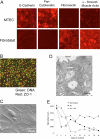Jun N-terminal kinase 1 regulates epithelial-to-mesenchymal transition induced by TGF-beta1
- PMID: 18334556
- PMCID: PMC2876720
- DOI: 10.1242/jcs.019455
Jun N-terminal kinase 1 regulates epithelial-to-mesenchymal transition induced by TGF-beta1
Abstract
Transforming growth factor beta1 (TGF-beta1) is a cardinal cytokine in the pathogenesis of airway remodeling, and promotes epithelial-to-mesenchymal transition (EMT). As a molecular interaction between TGF-beta1 and Jun N-terminal kinase (JNK) has been demonstrated, the goal of this study was to elucidate whether JNK plays a role in TGF-beta1-induced EMT. Primary cultures of mouse tracheal epithelial cells (MTEC) from wild-type, JNK1-/- or JNK2-/- mice were comparatively evaluated for their ability to undergo EMT in response to TGF-beta1. Wild-type MTEC exposed to TGF-beta1 demonstrated a prominent induction of mesenchymal mediators and a loss of epithelial markers, in conjunction with a loss of trans-epithelial resistance (TER). Significantly, TGF-beta1-mediated EMT was markedly blunted in epithelial cells lacking JNK1, while JNK2-/- MTEC underwent EMT in response to TGF-beta1 in a similar way to wild-type cells. Although Smad2/3 phosphorylation and nuclear localization of Smad4 were similar in JNK1-/- MTEC in response to TGF-beta1, Smad DNA-binding activity was diminished. Gene expression profiling demonstrated a global suppression of TGF-beta1-modulated genes, including regulators of EMT in JNK1-/- MTEC, in comparison with wild-type cells. In aggregate, these results illuminate the novel role of airway epithelial-dependent JNK1 activation in EMT.
Figures







References
-
- Bolstad BM, Irizarry RA, Astrand M, Speed TP. A comparison of normalization methods for high density oligonucleotide array data based on variance and bias. Bioinformatics. 2003;19:185–193. - PubMed
-
- Davis RJ. Signal transduction by the JNK group of MAP kinases. Cell. 2000;103:239–252. - PubMed
-
- Dennler S, Prunier C, Ferrand N, Gauthier JM, Atfi A. c-Jun inhibits transforming growth factor beta-mediated transcription by repressing Smad3 transcriptional activity. J. Biol. Chem. 2000;275:28858–28865. - PubMed
-
- Derynck R, Zhang YE. Smad-dependent and Smad-independent pathways in TGF-beta family signalling. Nature. 2003;425:577–584. - PubMed
Publication types
MeSH terms
Substances
Grants and funding
LinkOut - more resources
Full Text Sources
Other Literature Sources
Molecular Biology Databases
Research Materials
Miscellaneous

